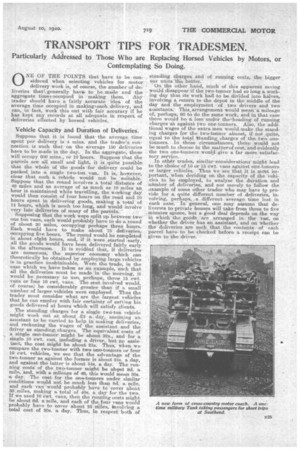TRANSPORT TIPS FOR TRADESMEN.
Page 23

If you've noticed an error in this article please click here to report it so we can fix it.
Particularly Addressed to Those Who are Replacing Horsed Vehicles by Motors, or Contemplating So Doing.
•0 NE OF THE POINTS that have to be considered when selecting vehicles for motor delivery work is, of course, the number of deliveries thaf:-, generally have, to be. made and the aggregate time occupiedin making them. Any trader should • have a fairly accurate idea of the average time occupied in making-leach delivery, and can, in fact, work this out with fair accuracy if he has kept any records at all adequate in respect of deliveries effected by horsed vehicles.
Vehicle Capacity and Duration of Deliveries.
Suppose that it is found that the average time spent per delivery is 4 mins. and the trader's connection is such that on the average 150 deliveries halve to be made in the day. In the aggregate, these will occupy 600 mins., or 10 hours. Suppose that the parcels are all small and light, it is quite possible that' the whole of the goods •for delivery could be packed into a single two-ton van.• It is, however, clear that such a vehicle would not be suitable. Suppose that the round involves a total distance of 40 miles and an average of as much as 10 miles an hour is maintained while travelling, the working day would then consist of four hours on the road and 10 hours spent in delivering goods, making a total 'of 14 hours, which is much too long, and would involve very late deliveries of many of the parcels. ' Supposing that the work were split up between two one ton vans, each would probably have to do a'round of about 30 miles, occupying perhaps three hours. Each . would have to make about 75 deliveries, occupying five hours. The round: would be completed in about eight hours, and, if it were started early, all the goods would have been delivered fairly early in the afternoon. It is evident that, if deliveries are numerous, the superior economy which can theoretically be obtained by employing large vehicles is in practice unobtainable Were the trade, in the case which we have taken as an example, such that all the deliveries must be made in the, morning, it would be necessary to use, perhaps, three 15 cwt. vans or loin. 10 cwt. vans. The cost involved would, of course; be considerably greater than if a small number of larger vehicles were employed. Thus the trader must consider what are the largest vehicles that he can employ with fair certainty of getting his goods delivered at hours -which will satisfy clients.
The standing charges for a single two-ton vehicle might work out at about 22 a day, assuming an assistant to be carried to help in making deliveries, and reckoning the wages of the assistant and the driver as standing; charges. The equivalent costs of a single one-tonner might be about 32s., and for a single 10 cwt. van, including a driver, but no assistant, the cost might be about 21s. Thus, when we compare the two-tonner with two one-tonners or four 10 cwt. vehicles, we see that the advantage of the two-tanner as against the former is about 24s. a day, and against the latter is about 44s. a day. The running costs of the twoetonner might be about 9d. a mile, :and, with a mileage of 40, this would mean 30s. a day. The cost for the one-tonnera under similar conditions would not be much less than 8d. a, mile, and each van would probably have to cover about 30; miles, making a total of 40s. a day for the two. If we used 10 cwt. vans, then the running costs might be about 6d. a mile, and each of the four vans would probably have to cover about 25 miles, involving a total cost of 50s. a day. Thus, in respect both of
standing charges and of running casts, the bigger our units the better.
On the other hand, much of this apparent saving would disappear if the two-tonner had so long a workin,g. day that its work had to be divided into halves, involving a return to the depot in the middle of the day and the employment of, two drivers and two assistants. This., arrangement would mean' a mileage of, perhaps, 60 to do the same work, and in that ease there would be a. loss under thelheading of running charges as against two one-tonners. Also, the additional wages of the extra Men would make the standing charges for the two-tonner almost, if not quite, equal to the total ttandina charges of the two onetonners. In these circumstances, there would not be-much to choose in the matter of cost, and evidently the two oneetonners would. give a far more satisfactory service. In other trades, similarconsiderations' might lead to the choice' of10 or 15 cwt. vans agaiest one-tonners or larger vehicles. • Thus we see that it is mast important, when deciding. on the capacityof the vehicle's to he employed, to analyse the duration and number of deliveries, and not merely to follow the example of -some Other trader who may have to provide for a quite different number of deliveries involving, perhaps, .a different average time lest in each case. In general., one may assume that deliveries to private houses will take from three to five minutes apiece, but a good deal depends on the way in which-the goods are arranged in. the van, on whether the driver has an assistant, and on whether the deliveries are such that the contents of each parcel have to be checked before a receipt can be given to the driver.






























